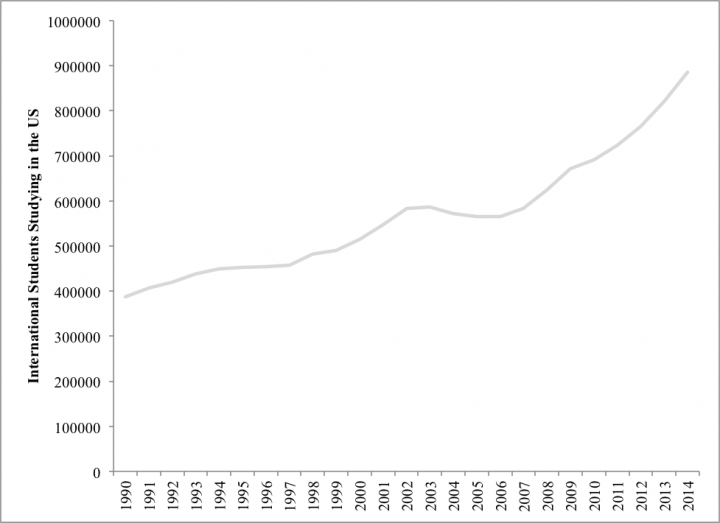With Kirk Heffelmire
Here’s a ranking in which the United States comes out on top: American universities attract more international students than any other country (according to UNESCO). About one in five students in the world who study abroad choose the U.S. as their destination.
This is a very good thing, because international students enrich the intellectual and cultural life of our universities, help build invaluable social capital, and bring economic benefits to our communities.
A couple of weeks ago, the Institute of International Education (IIE) released their latest data on international students in the United States. The number of international students studying in U.S. colleges and universities has risen dramatically over the past five years, following a general upward trend over the past two decades.
The graph above shows the sharp increase in the international student population over the past few years, in addition to the long-term growth since 1990. The total population of international students in the U.S. grew more than 8 percent since the 2012-13 academic year, compared to a 0.1 percent decline of higher education students in total. International students now compose 4.2 percent of all higher education students.
Unfortunately, while the numbers have been impressive nationally, growth has not kept pace in Virginia and the Washington, D.C., metro area. The average annual growth in international students in Virginia was 3.7 percent over the past four years, and 4.6 percent in the Washington, D.C., area over the same period. Both of these values are below the 6.4 percent average annual growth in international students across the U.S.
Students from China, India, and South Korea make up more than half of all international students studying in the U.S. Compared to the previous year, there was significant growth in the number of students coming from Kuwait (42.5 percent), Brazil (22.2 percent), and Saudi Arabia (21.0 percent). Students from China also grew rapidly between 2012-13 and 2013-14 increasing by 16.5 percent, nearly 39,000.
Students from abroad study the full variety of subjects, but 40 percent are in either business or engineering programs. Last year nearly 42 percent of international students were in undergraduate degree programs, and more than one-third were studying toward a graduate degree. In terms of funding, nearly 65 percent of international students rely on personal or family resources as their primary means of support.
International students bring significant economic benefits in terms of spending and employment. The IIE estimates that international students added more than $26 billion to the U.S. economy the past academic year. The IIE also reports that three U.S. jobs are created or supported for every seven international students who come to study, which amounts to more than 340,000 jobs across the U.S. In Virginia, international students contributed more than $487 million to the Commonwealth’s economy.
At Mason, international students contributed nearly $70 million to the local economy and created or supported 1,150 jobs during the 2013-14 academic year. This contribution is more than 14 percent of the statewide contribution made by all international students in Virginia. Across the Commonwealth, only Virginia Tech had more international students enrolled last year. Overall, Virginia ranked 14th in total international students among all states and D.C. However, Virginia was ranked 10th in 2001, and the slower growth rate mentioned above gives concern that Virginia higher education may no longer be as competitive when attracting international students.
This may help explain why I agreed to embark on a crazy short trip to Asia this week, even it meant that I would spend almost as much time flying as on the ground (ouch!). First stop, South Korea, where visited our campus in Songdo/Incheon and had meetings with students, faculty and partners. Second stop, Hong Kong, where tomorrow I’ll address the annual conference of our partner INTO. Both are critical initiatives in our efforts to increase the number of international students on our campus, a strategic goal for our university and an important outcome for our community.
I may be slightly biased by the fact that I once was an international student myself and that the experience changed my life in many ways. Regardless, the truth is that international students make up an important part of U.S. colleges and universities, and bring with them valuable economic and cultural contributions. The continuing growth of the international student population studying in the U.S. is encouraging and signifies the U.S. as a leader in higher education. We need to make sure that Virginia and the Washington, D.C., area stay competitive with other parts of the country and attract a growing share of those students.

